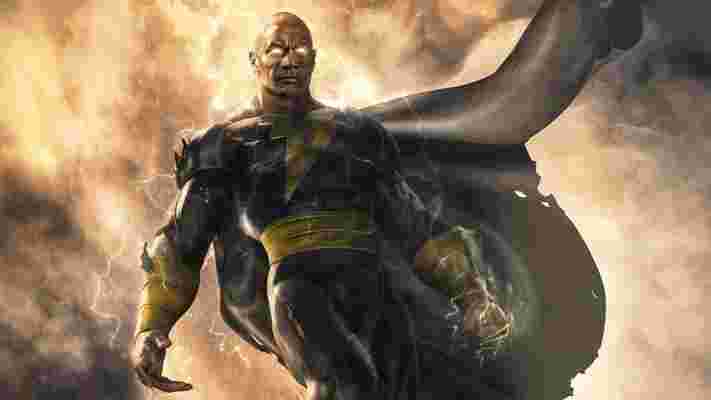Love, Death and Robots volume 3 may be the most bizarre and twisted season yet
The official trailer for Love, Death & Robots volume 3 has landed online – and it looks like it'll be the show's most bizarre season yet.
Released on Netflix 's social media channels on Monday (May 9), the trailer reveals the episode titles for season 3's nine episodes before giving us a brief look at, well, how they'll look. Based on the footage within, fans best prepare themselves for more sci-fi, horror, dystopian, existential, and humorous antics from the near-10 episode season.
We already knew that Love, Death & Robots volume 3 would land on Netflix on May 20 . With its release less than two weeks away, it's high time that we saw more about what its episodes would entail.
Check out the official trailer below:
The teaser confirms that acclaimed director David Fincher (Mank, Mindhunter) will make his animated directorial debut in the Netflix show that he co-executively produces alongside Tim Miller. Here's hoping that Fincher's iconic filming style and techniques are on show in the entry he's helmed.
Alberto Mielgo, whose season 1 episode The Witness won three Emmys, is also back to helm the third season's final entry called Jibaro. Meanwhile, the season opener – Three Robots: Exit Strategies – marks the first time that a season of Love, Death & Robots has contained a direct sequel to a previous episode.
Studios including Miller's Blur production company, Sony Pictures Imageworks, and Pinkman – who have previously animated multiple entries in Love, Death & Robots – also return to deliver gorgeous and grotesque visuals in equal measure.
Here's a full rundown of every Love, Death & Robots volume 3 episodic title, plus those involved in each one's production:
Fans who want to catch a glimpse of Love, Death & Robots volume 3 can do so by signing up to watch a livestream Q&A with Tim Miller, David Fincher, and Jennifer Yuh Nelson, too. The event, which will take place on Wednesday, May 10, will be shown at multiple Alamo Drafthouse locations across the US. Those wishing to tune in can do so by signing up via this link .
For more on Love, Death & Robots, read our expert guide on every one of the animated anthology series' 26 episodes to date . We'll be updating it once volume 3 drops, too, so be sure to check back and see if you agree with us on May 20.
Analysis: will Love, Death & Robots volume 3 be the best season yet?

It's possible. The volume 3 teaser trailer suggests that the upcoming batch of episodes will be some of the most intriguing (from a plot perspective) and beautiful we've seen so far. Of course, that doesn't necessarily mean that they will be. But, with the likes of Mielgo returning, Fincher directing an episode, and each standalone tale tapping into each studio's unique and aesthetically pleasing animation style, we're confident that volume 3 will be the best season yet.
There's data (albeit a small amount) implying that Love, Death & Robots volume 3 could be the best season in the animated show's history, too, based on how volume 2 was better received (by critics) than the first volume was. According to review aggregator website Rotten Tomatoes, the 18-strong first volume holds a 77% rating among critics . Meanwhile, volume 2 – with its eight episodes – is rated even higher; the second instalment accumulating an 85% rating from multiple reviewers .
Take a look at the accumulative scores from general TV aficionados, however, and you may worry about volume 3's chances of maintaining that upward trajectory. Audiences adored the show's first instalment, with its 92% certified fresh score confirming as much. Volume 2, though, received a paltry 57% rating by comparison. It's unclear if Love, Death & Robots' second outing was affected by the lack of episodes it contained (18 in volume 1 compared to 8 in volume 2), or whether its stories simply didn't resonate with viewers.
Whatever the reason, Love, Death & Robots volume 3 could end up splitting critics and fans' opinions on the series more so than its predecessor. Based on what the trailer teased, plus Mielgo and Fincher's involvement in specific episodes, though, we're quietly confident that volume 3 will deliver a season that professional critics and animation fans will equally enjoy.
Bad news for DC movie fans, as pandemic delays tons of superhero release dates
Warner Bros. has announced substantial delays for many of the blockbusters on its 2022 and 2023 slate, including long-awaited DC comic book movies.
The studio confirmed yesterday (March 9) that it was shuffling the release dates for much of its forthcoming DCEU movies as well as the much-anticipated Charlie and the Chocolate Factory prequel Wonka and the sequel to mega-shark bloodfest, The Meg.
Among the delays are big moves for Aquaman sequel, Aquaman and the Lost Kingdom , a relatively small push-back for new Dwayne 'The Rock' Johnson-led superhero smash-up Black Adam , and another meaty delay for Ezra Miller's solo debut as The Flash , which was originally supposed to come out all the way back in 2016.
What dates are shifting?
The biggest delay is for The Flash, the movie that was finally going to see Ezra Miller's take on speedy superhero getting top of the bill. Delayed and delayed by creative changes from its original release date back in 2016, things finally looked to be motoring with It director Andy Muschietti at the helm. Sadly, it's been delayed again, from a planned release date of November 4 this year to June 23 in 2023. If you're wondering how to watch the DC movies in order , we'll have to wait even longer to see how its timeline-hopping exploits effect the chronology of the franchise.
Aquaman sequel, Aquaman and the Lost Kingdom, has lost its festive slot for this year, where it had been due to debut in theaters on December 16. It'll now come out on March 17 in 2023. It's a smaller delay for Johnson and Black Adam, which has been bumped from July 29 this summer to October 21.
Timothée Chalamet’s new take on Willie Wonka, where he will team up with Paddington director Paul King for a musical prequel to Charlie and the Chocolate Factory, is also going back. That had been booked for Aquaman's old slot on March 17 in 2023, and now will get a wintery bow on December 15 in 2023.
In other Dwayne 'The Rock' Johnson news, his starry animated adventure, DC League of Super-Pets is also going back, but just by a few weeks. It was originally due in theaters on May 20, now it'll be July 29.
Finally, after a long spell of development, there's a release date for Jason Statham's sequel to mega-shark blockbuster The Meg. Meg 2: The Trench will drop on August 4 in 2023.

Is there any good news?
One piece. Shazam! Fury of the Gods, which hadn't been due out until June of 2023, will now take Aquaman's spot and open on December 16 in 2022, a move up of six months.
What's the reason for the delays?
According to the Hollywood Reporter , it's our old friend Covid-19. All of these movies require an epic amount of work in the special effects departments, and, with added sickness among staff and delays caused by the pandemic, they can't get the work finished fast enough.
Are fitness trackers accurate?
Many of us rely on fitness trackers to measure things like our heart rate, step count and sleep quality – but are they really accurate? The answer depends on which health metric you’re looking at. Most of them can give you a good idea of your step count if you’re going on a hike, but even the best fitness trackers struggle to accurately record when you’re sleeping and when you’re awake.
We combed through the latest studies – and spoke to experts – to find out which metrics you can really trust.
Calories
A 2018 study carried out by researchers at the Technical University of Munich found that fitness trackers were woefully inaccurate at calculating energy expenditure (calories burned). The damning report concludes that trackers aren’t accurate enough to be used in either sporting pursuits or healthcare.
Personal trainer at SIX3NINE Emily Taylor explains why some trackers may not be accurate for calorie burn: “There are loads of different factors that come into play when estimating calorie burn, and not all of them can be taken into account by the formulas that these trackers use to predict energy expenditure.”
Some fitness trackers only count the number of calories you burn through exercise, while others look at your calorie burn from the whole day. It might be useful to look at the calories burned as a kind of guide, showing days where you’ve had more active periods – but don’t rely on it too heavily if you’re trying to calculate calorie intake versus energy expenditure.

Step tracking

Most wearables use motion sensors to record how many steps we take, but studies have found that your pace can affect accuracy.
A 2020 paper published in the International Journal of Environmental Research and Public Health found that lengthy, brisk strolls were calculated more accurately than shorter walks. So your watch might be able to count your steps on a hike but it won’t register your movements round the house. A different study from 2017, published in peer-reviewed journal JMIR mHealth and uHealth, found that the accuracy on fitness trackers was negatively affected by walking aids, like a walking stick or shopping cart.
No study has been able to conclude that trackers are 100% accurate at step counting, so you might want to take this metric with a pinch of salt, too, but it’s usually more accurate than recorded calories and heart rate.
Heart rate
“Some trackers use an ECG [electrocardiogram] heart rate belt, which measures the heart rate using electrical waves, while others use an optical heart rate monitor which measures it by light,” explains Mari Thomas, founder of Maaree sports bras and former fitness tracker tester for TomTom. “Optical heart rate is the least accurate of the two as external rhythms like your running cadence can interfere if they align too closely.”
A 2017 study conducted by The Heart and Vascular Institute tested fitness trackers and chest-worn monitors against a standard ECG. The researchers used a sample of 50 people, and measured their heart rate with the fitness trackers as they walked and ran on the treadmill. They found that the chest-worn monitors were the most accurate and matched up with the ECG readings.
Thomas explains why fitness trackers could be less accurate: “The surface of the wrist needs to be in close and constant contact with the receiver, which can be difficult if one has a smaller or harder service area here.
“Perfusion can also play a big role – and low perfusion will have a detrimental effect on OHR performance. Factors that affect perfusion can include skin tone and outside temperature.”
Sleep
The most accurate way to get a reading of how we’re sleeping is by having a polysomnography test, which measures things like brain waves and heart rate to get an overall picture of your sleep health.
Fitness trackers typically use sensors to measure our movement while we sleep, but some research says that their sleep tracking doesn’t measure up to the traditional methods – especially when it comes to measuring our sleep cycles, including deep, light and REM (rapid eye movement).
A 2019 study by researchers from the Yale schools of nursing and medicine showed that when fitness trackers record sleep and wake up times, they are only 78% accurate. And the same study found that the trackers were terrible when it came to actually recording the moment wearers fell asleep, with only 38% getting it right.
However, despite how inaccurate fitness trackers can be, at times, Emily says that they are great for one thing: “Trackers can provide the accountability and motivation needed to implement positive behaviour change. Having a quantifiable goal to work towards (like a step count and sleep target) can be very valuable.”
